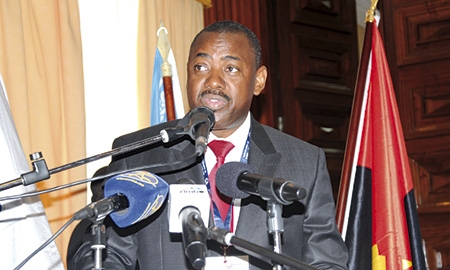“I am a builder. I like it when things are well made.” That is how Transport Minister Augusto da Silva Tomás sees himself and one of the reasons why Angola’s President, José Eduardo Dos Santos, has placed his utmost confidence in Minister Tomás’ initiatives aimed at restoring and renewing the country’s transportation infrastructure.
Even when the civil war that ravaged its roads, rail lines and bridges was still raging, Angola’s first president Agostinho Neto made it very clear that “the transportation system is the backbone of the Angolan economy.” That has been interpreted as a mandate by his successor in office as well as by those individuals like Minister Tomás who make things happen on the ground.
“We are still working to reverse what our country went through” during more than a quarter of a century of violent conflict, says Mr. Dos Santos. “Our main opportunities have come as a result of political stability, which has to be consolidated before economic and social stability can be achieved.”
There are even more compelling reasons why the government has given its priority attention to this sector and privileged access to export revenues. First is the sheer size of the place. At 481,354 square miles, or nearly twice the area of Texas, the distances covered by 21 million inhabitants getting from one place to another present a permanent challenge. But the government is fully aware that the cost-efficient movement of people and goods remains a requisite for serious economic development.
Aligned with that on-the-ground reality is the surge in internal migration, as people uproot from the country and move to the urban centers, where their presence is a strain on public transport and road maintenance. By the same token, emphasis on economic diversification has made it imperative to develop new routes from the commodities’ place of origin to their exit point. Examples here would include premium coffee varieties (coffee was the county’s biggest export earner until the civil war broke out) or the largely untapped mineral riches of Cabinda province “adrift on the map” and sharing no common border with the rest of Angola.
Emphasis on economic diversification has made it imperative to develop new routes from the commodities’ place of origin to their exit point.
|
Angola is fortunate that it has cargo ports at Cabinda and Namibe, in the north and south of the country, respectively, plus recently modernized import-only facilities at Lobito. Largest and busiest of all is the deepwater
port of Luanda, which has four container terminals, five cargo berths, and 18 warehouses offering 592,000 square feet of covered storage.
“In addition,” notes Mr. Tomás, “we are tackling the issue of cabotage, with a view to connecting people from Cabinda and Zaire by sea. Maritime terminals in both provinces could enable roll-on/roll-off boats to transport persons, freight, equipment, cars and other goods.”
Air travel is another way of shortening distances and neutralizing nature’s barriers. It is no secret that in 2007 the national flag carrier
TAAG was banned from European Union airspace for two years owing to safety shortcomings. According to Mr. Tomás, that may have been a blessing in disguise, or at the very least a wake-up call.
“Our entire aviation sector needed to be restructured. So we reformulated its whole legislative and regulatory framework, with more than 3,500 pages of agreements reached with the International Civil Aviation Organization (ICAO), the European Union, the International Air Transport Association (IATA) and others. Our entity for regulation and supervision of the sector, the Instituto Nacional da Aviação Civil (INAVIC) has also been restructured.
“Secondly, we modernized infrastructure. The new international airport in Luanda will be among Africa’s largest; a regional hub for 15 million passengers a year, with 31 jet bridges for domestic and international connections.”
The rebirth of Angola’s war-ravaged railroads is also a particular source of pride to Mr. Tomás. Three networks are now in operation: the Luanda (295 miles), Moçâmedes (605 miles) and Benguela (855 miles) lines. “We acquired new locomotives, new bogies and wagons to transport people and freight,” the minister points out, and emphasizes the railroads’ role in uniting the coastal regions with the interior.
It would be restating the obvious to acknowledge that roads are at the very top of the transport ministry’s repair or replace list. “We developed Plans for Transport and Logistics for all the provinces,” recounts Mr. Tomás, “so we have now a fleet of 5,000 coaches to provide inter-communal, interprovincial and urban transportation in each provincial capital.”
All those sectors are important in their own right, but to hear Mr. Tomás tell it, Angola’s future transportation needs will not so readily lend themselves to single-minded solutions. Instead, the mid-term strategy call for them to be gathered into an intermodal web that gives access to just about anywhere one might care to go.
Mr. Tomás explains: “The four main ports are linked to national and international airports, which in turn are linked to railways. We have three main corridors under development. One is at Luanda, linking the port, airport and rail lines. Then there is Lobito Transport Corridor connecting the
port of Lobito, Catumbela airport and the Benguela railroad.
“Finally we have the Corridor for the Development of Namibe that connects the regional airport, the port and the Moçâmedes rail network. The next step is to link this enhanced production platform of goods and services to neighboring countries, like Congo, Zambia and Namibia, through air, maritime, road and railway agreements.”

0 COMMENTS